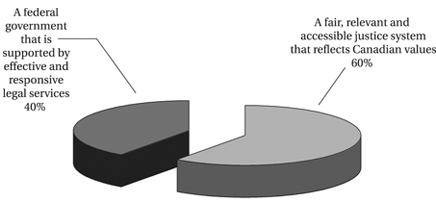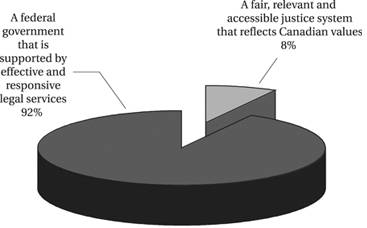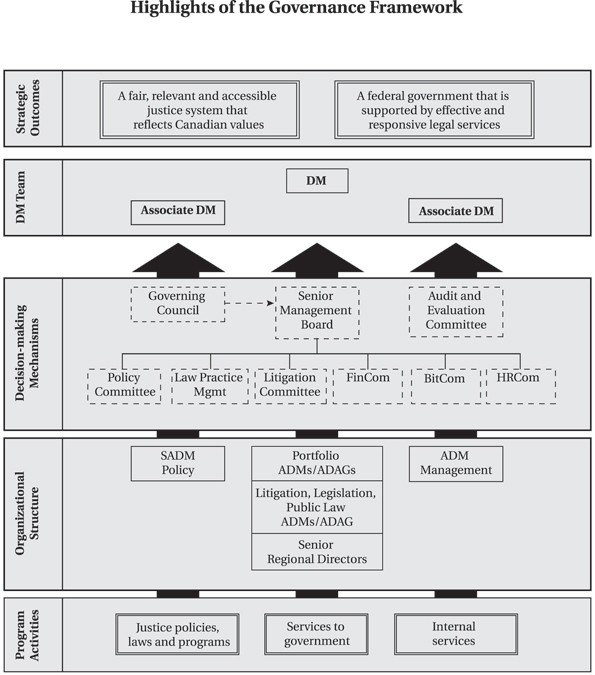Common menu bar links
Breadcrumb Trail
ARCHIVED - Department of Justice Canada
 This page has been archived.
This page has been archived.
Archived Content
Information identified as archived on the Web is for reference, research or recordkeeping purposes. It has not been altered or updated after the date of archiving. Web pages that are archived on the Web are not subject to the Government of Canada Web Standards. As per the Communications Policy of the Government of Canada, you can request alternate formats on the "Contact Us" page.
Section I – Overview
Message from the Minister of Justice

I am pleased to report on the performance of the Department of Justice for 2007–2008.
The Department remains committed to fulfilling its unique role as the federal government’s steward of Canada’s justice system. Over this past year, the Department has continued to support the Government of Canada in its pursuit of a justice system that is increasingly accessible and effective, as well as accountable and responsive.
The Department played a key role in helping the Government of Canada to deliver its legislative agenda over the reporting period: the House passed legislation with regard to conditional sentencing and the age of protection, and bills imposing mandatory minimum penalties for gun crimes and bail provisions for offences involving firearms and drug- and alcohol-impaired driving received Royal Assent.
In addition, the Department was very active in developing and implementing the new National Anti-Drug Strategy. This collaborative effort partnered the Department of Justice with Public Safety Canada and Health Canada to prevent illegal drug use in young people, treat people who have drug addictions and fight related crime. Activities under the Strategy included introducing legislation to ensure mandatory jail time for serious drug crimes.
As well, the Department launched a review of the Youth Criminal Justice Act, beginning with a meeting in February in Ottawa with the provincial/territorial Attorneys General. This review comes as part of the government’s commitment to strengthen the Act, which includes introducing legislation to provide new measures to protect communities from young offenders who pose a significant risk to public safety.
In other efforts to build a more effective and accessible justice system, the Department worked closely with the Steering Committee on Justice Efficiencies and Access. As well, the Department supported the establishment of the new arm’s-length Office of the Federal Ombudsman for Victims of Crime.
As Minister of Justice, I will continue to work with all levels of government, our stakeholders and the public to strengthen the security of Canadians and ensure that they have confidence in our justice system. And as always, I will be relying on the professionalism and expertise of the public servants of the Department, as our government continues to pursue this agenda.
I invite you to read this document for further details regarding our performance over the past year.
Original copy signed by
The Honourable Rob Nicholson, P.C., M.P.
Minister of Justice and Attorney General of Canada
Message from the Deputy Minister
I am pleased to present the 2007–2008 Departmental Performance Report for the Department of Justice. In reading this report, the reader will gain an understanding of what the Department of Justice accomplished with the resources entrusted to it by Parliament.
The report is divided into four sections beginning with an overview that provides the required information in a standard format. The second section provides details regarding the expenditures and results achieved broken down by program activity. The third section presents comprehensive information about the Department’s expenditures, while the fourth and final section provides information concerning some of the Department’s key corporate initiatives.
Throughout this report, we have detailed the active role played by the Department in advancing the government’s five key priorities.1 The Department played a key role in: supporting the Minister of Justice in delivering on the government’s agenda on Tackling Crime and Strengthening the Security of Canadians, as well as helping develop Canada’s new National Anti-Drug Strategy and improving the Youth Criminal Justice Act, beginning in early 2008 with an overall review of the Act.
As well, the Department’s accomplishments are rooted in its critical role in helping client departments to achieve their priorities through the provision of an integrated suite of legal advisory, legislative and litigation services to government. In this vein, over the course of 2007–08, the Department supported the Government of Canada in pursuing a comprehensive legislative agenda, resulting in 63 bills being tabled in Parliament and 474 regulations being published in the Canada Gazette. The Department also provided legal policy advice on a broad range of files relating to such diverse subjects as protecting Canadian sovereignty, enhancing border security, protecting the integrity of the food supply chain, and determining the implications of spending and taxation measures. As well, the Department successfully represented the Crown’s interests in several major court cases.
And on the management side, our Management Accountability Framework ratings from Treasury Board Secretariat have continued to show that our management practices and capacity support sound stewardship of the resources entrusted to us. I take pride in the Department’s achievements. They represent some of the key building blocks that will help us in our public service renewal efforts as we strive to ensure that the Department is an organization well positioned to meet the ever-increasing demands on government in the twenty-first century.
1 http://www.sft-ddt.gc.ca/eng/media.asp
Management Representation Statement
I submit for tabling in Parliament, the 2007–08 Departmental Performance Report for the Department of Justice Canada.
This document has been prepared based on the reporting principles contained in the Guide to the Preparation of Part III of the 2007–2008 Estimates: Reports on Plans and Priorities and Departmental Performance Reports:
- It adheres to the specific reporting requirements outlined in the Treasury Board Secretariat guidance;
- It is based on the department’s approved Strategic Outcome(s) and Program Activity Architecture that were approved by the Treasury Board;
- It presents consistent, comprehensive, balanced and reliable information;
- It provides a basis of accountability for the results achieved with the resources and authorities entrusted to it; and
- It reports finances based on approved numbers from the Estimates and the Public Accounts of Canada.
Original copy signed by
John H. Sims
Deputy Minister of Justice and Deputy Attorney General of Canada
Summary Information
The justice system defines and prescribes the balance between collective and individual rights and responsibilities that ensure a well-ordered society. As such, it affects almost every facet of Canadians’ daily lives from guiding everyday activities that ensure our safety to supporting social policies and social benefits, regulating our economy, and offering ways to resolve disputes peacefully where there are disagreements or conflicts between individuals, organizations and/or governments.
Maintaining a system that serves all Canadians is a central focus for the Department of Justice (Department, or DoJ), which strives to ensure that the system remains fair, accessible and efficient as it evolves in response to social change.
The Department of Justice plays an important role in supporting the Government of Canada’s priority of protecting Canadian families and communities. Furthermore, the Department of Justice is a federal organization that supports the Government of Canada’s priorities through the provision of an integrated suite of common legal services to federal departments and agencies.
Role of the Department
The Department of Justice is headed by the Minister of Justice and Attorney General of Canada. The responsibilities of the Minister and the Attorney General are set out in the Department of Justice Act and 47 other Acts of Parliament. The Department of Justice fulfills three distinctive roles within the Government of Canada, acting as:
- a policy department with broad responsibilities for overseeing all matters relating to the administration of justice that fall within the federal domain;
- a provider of a range of legal advisory, litigation and legislative services to government departments and agencies; and
- the central agency responsible for supporting the Minister in advising Cabinet on all legal matters including the constitutionality of government activities.
The Department’s mission is threefold:
- to support the Minister of Justice in working to ensure that Canada is a just and law-abiding society with an accessible, efficient and fair system of justice;
- to provide high-quality legal services and counsel to the government and to client departments and agencies; and
- to promote respect for rights and freedoms, the rule of law and the Constitution.
Strategic Outcomes and Program Activity Architecture
In supporting the Minister of Justice and Attorney General of Canada, the Department of Justice strives to attain two overarching strategic outcomes: (i) a fair, relevant and accessible justice system that reflects Canadian values; and (ii) a federal government that is supported by effective and responsive legal services.
The Department of Justice’s two strategic outcomes reflect the dual responsibilities of the Minister of Justice and Attorney General of Canada. While the Minister of Justice is concerned with questions of policy particularly as they relate to his role as a steward of the Canadian justice system, the Attorney General of Canada is the chief law officer for the Crown.
In support of the first strategic outcome, the Department has two program activities — Justice policies, laws and programs, and the Office of the Federal Ombudsman for Victims of Crime. The Department’s program sub-activities (i.e., criminal justice, family justice, access to justice, Aboriginal justice, and private international and public law) in support of the first strategic outcome reflect the specific domains within which the Department supports the government’s legal policy and program initiatives.
In support of its second strategic outcome, the Department has one program activity — Services to government. Through this program activity, the Department delivers an integrated suite of common legal advisory, litigation and legislative drafting services through its Portfolios to government departments and agencies. These services support overall government priorities and promote respect for the rule of law and the Constitution.
Department of Justice Program Activity Architecture
|
Strategic Outcomes
|
A fair, relevant and accessible justice system that reflects Canadian values
|
A federal government that is supported by effective and responsive legal services
|
|
| A1 Justice policies, laws and programs | B1 Services to government | C1 Internal services* | |
|
A1.1 Aboriginal justice A1.2 Criminal justice A1.3 Family justice A1.4 Access to justice A1.5 Private international and public law A2 Office of the Federal Ombudsman for Victims of Crime |
B1.1 Legal services to government-at-large and the Justice Portfolio B1.2 Legal services to the Aboriginal Affairs Portfolio B1.3 Legal services to the Business and Regulatory Law Portfolio B1.4 Legal services to the Central Agencies Portfolio B1.5 Legal services to the Citizenship, Immigration and Public Safety Portfolio B1.6 Legal services to the Tax Law Portfolio |
C1.1 Management and Oversight Services C1.2 Evaluation Services C1.3 Internal Audit Services C1.4 Public Affairs/ Communications Services C1.5 Financial Management Services C1.6 Human Resources Management C1.7 Information Management Services C1.8 Information Technology Services C1.9 Legal Services C1.10 Other Support Services |
* It should be noted that Program Activity C1 – Internal services is proportionally allocated across program activities A1, A2 and B1 and therefore does not appear in financial tables.
Program Activity Architecture (PAA) Crosswalk|
($ millions) |
New PAA (2008-09) |
||||
|
Justice Policies, Laws and Programs (A1) |
The Office of the Federal Ombudsman for Victims of Crime (A2) |
Services to Government (B1) |
Total |
||
| Old PAA (2007-08) |
Developing Policies |
39.5 |
|
39.5 |
|
|
Developing and |
368.8 |
368.8 |
|||
|
Office of the Federal Ombudsman for Victims |
0.7 |
0.7 |
|||
|
Providing Legal Advisory, Litigation and Legislative Services to Government (B1) |
277.2 |
277.2 |
|||
|
Total |
408.3 |
0.7 |
277.2 |
686.2 |
|
Note: The Office of the Federal Ombudsman for Victims of Crime spending authority is included in the Department
of Justice but reports independently to the Minister of Justice.
Financial and Human Resources
Financial Resources (in millions of dollars)
|
Planned Spending
|
Total Authorities
|
Actual Spending
|
|
717.7
|
733.9
|
686.2
|
For fiscal year 2007-2008, actual spending for the Department totalled $686.2M, which was $47.7 million less than the total spending levels authorized by Parliament.2
Approximately 60 per cent of the department’s expenditures ($409 million) were in support of a fair, relevant and accessible justice system that reflects Canadian values. Most of these expenditures (88 per cent) were in the form of grants and contributions, of which the vast majority were to the provinces and territories to support their delivery of legal aid programs and youth justice services.
Approximately 40 per cent ($277.2 million) of departmental expenditures were related to supporting the federal government with effective and responsive legal services.
2007-2008 Actual Spending by Strategic Outcomes
2 Vote 1– Operating expenditures accounted for $29.7 million of the surplus while the remaining $18.0 million of the surplus was Vote 5 – Grants and Contribution expenses. The bulk of the surplus operating expenditures are related to delays in completing staffing processes and in higher than anticipated cost recoveries in the first year of operation of the department’s Net Vote Authority Regime. The surplus in grants and contribution stemmed primarily from lower than anticipated spending related to the following three contribution programs: Victims Fund, Integrated Market Enforcement Teams Reserve Fund and and Intensive Rehabilitative Custody and Supervision Program.
Summary of Performance by Program Activity
The table below summarizes the Department’s performance for fiscal year 2007–08 against the two strategic outcomes and the associated program activities.
|
Strategic Outcome I: Fair, relevant and accessible justice systems that reflects Canadian values |
|||
|
Program Activities |
Planned Spending |
Actual Spending |
Priorities |
|
Justice policies, laws and programs |
429.6 |
408.3 |
Ensuring an effective and accessible justice system (ongoing) Status: Met |
|
Protecting Canadian communities (ongoing) Status: Met |
|||
|
Office of the Federal Ombudsman for |
1.5 |
0.7 |
Note: Federal Ombudsman reports independently to |
|
Strategic Outcome II: Federal government supported by effective and responsive legal services |
|||
|
Program Activities |
Planned Spending |
Actual Spending |
Priorities |
|
Services to government |
286.6 |
277.2 |
Supporting government departments and agencies in achieving Government of Canada priorities (ongoing) Status: Met |
The Department met all of its priorities for fiscal year 2007–08. Further details about performance and results can be found in Section II of this report.
Human Resources (in full-time equivalents)
|
Planned
|
Actual
|
Difference
|
|
4,140
|
4,239
|
99
|
With 4,239 full-time equivalent employees during the reporting period, the Department of Justice is classified as “large” by the Canada Public Service Agency. While roughly one-half of departmental staff are lawyers, there are a number of other committed professionals including paralegals, social scientists, program managers, communications specialists, administrative services personnel, computer services professionals and financial officers. The vast majority of our human resources are dedicated to providing legal services to government.
2007-2008 Actual FTEs by Strategic Outcomes

Organizational Information
The Department maintains a policy and program development capacity in order to fulfill core departmental responsibilities associated with the administration of justice in Canada and to support the Government of Canada’s policy and program priorities related to safety and security.
To these ends, the Department develops and maintains strong working relationships with policy and program partners across the federal government as well as with counterparts in the provinces and territories and partners in non-governmental organizations and international institutions and organizations.
The Department provides legal services to government on a “portfolio” basis. Six Portfolios, described in greater detail in Section II, encompass the entire range of federal departments and agencies. The Department delivers services through a mix of co-located departmental legal services units, specialized branches located within the Department of Justice and a network of six regional offices located across the country.


Governance Framework
The Department’s Governance Framework maps the departmental organizational structure to the Program Activity Architecture. The Framework visually demonstrates the structure and decision-making mechanisms for priority setting and resource allocations/reallocations, and depicts how the Department coordinates and manages the achievements of its two core strategic outcomes — a fair, relevant and accessible justice system; and effective and responsive legal services to government.
The DM Team, which consists of the Deputy Minister, John Sims, and Associate Deputy Ministers Donna Miller and Yves Côté, leads the Governance Framework. Together its members share the workload and authority of the Office of the Deputy Minister in supporting the Minister and in providing active leadership in the delivery of timely and effective advice and legal services to client departments and their Deputy Ministers in support of government priorities and results for Canadians.
This approach to governance has been chosen to ensure that deputy-level attention is brought to bear on important departmental and whole-of-government files. To this end, each member of the DM Team assumes responsibility for providing guidance, direction and support across the Department in order to ensure that all senior executive managers have a direct link with a member of the DM Team on key files and on management issues.
Factors Affecting Our Operating Environment
Many factors influence our operating environment and thus have impacts on our policy and program development and implementation activities as well as our ability to effectively manage and deliver high-quality legal services.
Public Confidence in the Justice System
Public confidence in the justice system is affected by a variety of factors that are beyond the Department’s control, including the sensational media coverage of incidents of crime. Such coverage can have an impact upon individual perceptions of the efficacy of the justice system and of the risk to personal safety.
Additionally, factors such as the rising costs associated with obtaining access to justice have an impact on public confidence. As Canadians rely on the justice system to provide an independent and impartial forum for resolving disputes, the Department is keenly interested in the degree to which the public has confidence in the justice system at large.
In 2008, the National Justice Survey’s data suggested that 70 per cent of Canadians have a high or moderate confidence level in the adult criminal justice system while 59 per cent of Canadians have a high or moderate confidence level in the youth criminal justice system.
Jurisprudence and Legal Trends
As the Government of Canada’s “law firm,” it is incumbent upon the Department of Justice’s counsel to assess the implications of a wide variety of outcomes in the court system — both civil and criminal — and incorporate these analyses in the delivery of legal advisory, litigation and legislative services with a view to effectively manage legal risk. The Department must also continuously assess its capacity to address emerging issues such as those in the areas of international, Aboriginal, fiscal and commercial law.
Working with others
The justice system is multi-tiered and includes other participants such as nongovernmental and community-based organizations with whom we work to generate innovative ideas about how to improve access to the justice system, while respecting the diverse nature and needs of all Canadians. Similarly, we work with federal departments and agencies in areas such as safety and security and Aboriginal justice to help achieve overarching Government of Canada strategic outcomes. Some of the others with whom we work include:
- the Canadian public, including non-governmental and community-based organizations, and representatives of official language and minority communities;
- Parliamentarians;
- the Judiciary, the Bar, la Chambre des notaires du Québec;
- law faculties and the research community;
- approximately 50 federal client departments and agencies3 ;
- provinces and territories; and
- foreign governments and international organizations, directly and in conjunction with Foreign Affairs and International Trade Canada.
